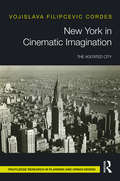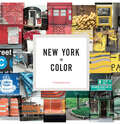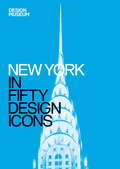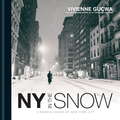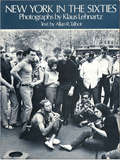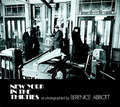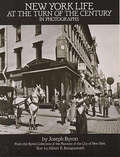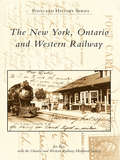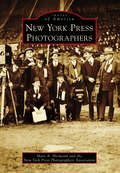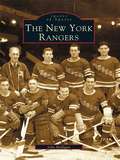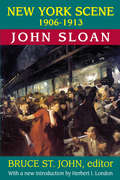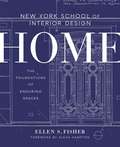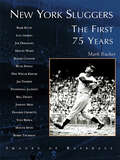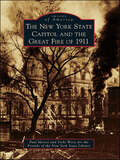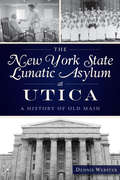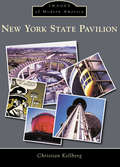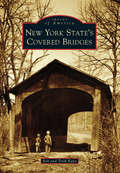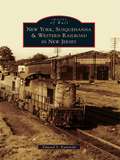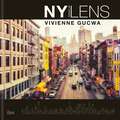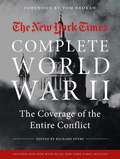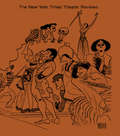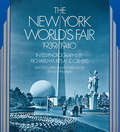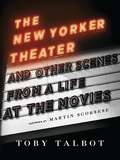- Table View
- List View
New York in Cinematic Imagination: The Agitated City
by Vojislava Filipcevic CordesNew York in Cinematic Imagination is an interdisciplinary study into urbanism and cinematic representations of the American metropolis in the twentieth century. It contextualizes spatial transformations and discourse about New York during the Great Depression and the Second World War, examining both imaginary narratives and documentary images of the city in film. The book argues that alternating endorsements and critiques of the 1920s machine age city are replaced in films of the 1930s and 1940s by a new critical theory of "agitated urban modernity" articulated against the backdrop of turbulent economic and social settings and the initial practices of urban renewal in the post-war period. Written for postgraduates and researchers in the fields of film, history and urban studies, with 40 black and white illustrations to work alongside the text, this book is an engaging study into cinematic representations of New York City.
New York in Color
by Nichole Robertson&“Organizes the city in an array of beautiful and cohesive shades . . . One of the best books about New York City by way of vibrant and striking images.&” —New York Simply This photographic portrait of New York captures the city as never before, in a vibrant visual tour, color by color. From Staten Island Ferry orange to taxicab yellow, photographer and writer Nichole Robertson brings New York&’s quintessential shades into focus, seeking out the city&’s hiding-in-plain-sight treasures: bananas sold streetside for a dollar, bright red &“no parking&” signs, stacks of delicious golden-brown pretzels, gleaming Art Deco gold archways. Arranged by color, these striking views portray the spirit of the city across every borough. A unique love letter to the iconic metropolis, this celebration of the city will charm locals as well as everyone who loves—or dreams of—visiting the Big Apple. Praise for Nichole Robertson&’s Paris in Love &“A beautiful ode that will leave you pining for Paris.&” —Lindsey Tramuta, author of The New Paris &“That magic feeling you get when you are falling in love with a person or place—in this case Paris!—is encapsulated in this stunning gem of a book.&” —Samantha Hahn, author of Well-Read Women &“We&’re smitten by Nichole Robertson&’s Paris in Love, which celebrates all things Parisian—especially crimson things, from raspberry tarts to scarlet mopeds, rosy begonias and glossy, berry-hued cafe chairs—in glorious photographs.&” —San Jose Mercury News
New York in Fifty Design Icons: Design Museum Fifty
by Design Museum Enterprise Limited Julie IovineIn this new series, the Design Museum looks at the fifty design icons of major cities around the world - icons that, when viewed together, inherently sum up the spirit of their city. Covering anything from buildings and monuments to a graffiti mural or an item of clothing, we are able to build up an intricate portrait of a city, layer by layer. From the infamous Chysler Building and the Brooklyn Bridge to the New York Yankees logo or CBGB's, the beating heart of the 1970s punk movement, New York is a tapestry of design masterpieces. Join Julie Iovine, architectural writer at the Wall Street Journal and formerly of the New York Times, as she unravels the visual history of one of our most famous and fascinating cities.Contents include:Empire State BuildingFlat Iron BuildingTiffany & Co. powder blueCBGBsRadio City Music HallStonewall, Christopher StreetStock Exchange bellMillionaire's Row, Fifth AvenueGuggenheim MuseumNew York Yankees logo...and many more.
New York In The Snow
by Vivienne GucwaThe iconic city of New York is a bustling, heady metropolis that, thanks to the power of media, everyone in the world knows intimately, even if they've never been. But every once in a while it changes completely. At first a few flakes will fall, then more, and more. Hardened New Yorkers rush for warmth and, while they're absent, an amazing, glistening almost deserted winter wonderland momentarily appears.It is these moments that phenomenally popular photo-blogger Vivienne Gucwa lives for. She has been documenting them for more than a decade, rushing out to capture the city in snow. Of all the photos that have made her the celebrated, award-winning success that she is, it is these that are most loved, both online and in print, so we offer them here in a sumptous volume to be enjoyed by anyone who loves New York, whether from afar, as an occasional visitor, or if you've never left the Big Apple.
New York In The Snow
by Vivienne GucwaThe iconic city of New York is a bustling, heady metropolis that, thanks to the power of media, everyone in the world knows intimately, even if they've never been. But every once in a while it changes completely. At first a few flakes will fall, then more, and more. Hardened New Yorkers rush for warmth and, while they're absent, an amazing, glistening almost deserted winter wonderland momentarily appears.It is these moments that phenomenally popular photo-blogger Vivienne Gucwa lives for. She has been documenting them for more than a decade, rushing out to capture the city in snow. Of all the photos that have made her the celebrated, award-winning success that she is, it is these that are most loved, both online and in print, so we offer them here in a sumptous volume to be enjoyed by anyone who loves New York, whether from afar, as an occasional visitor, or if you've never left the Big Apple.
New York in the Sixties
by Allan R. Talbot Klaus LehnartzCompelling photographs offer a vivid and varied tableau of daily life: shoppers, subways, Central Park, Coney Island, dozens of other revealing views of the city. 159 photographs by Lehnartz.
New York in the Thirties (New York City)
by Berenice AbbottNearly 100 classic images by noted photographer: Rockefeller Center on the rise, Bowery restaurants, dramatic views of the City's bridges, Washington Square, old movie houses, rows of old tenements laced with laundry, Wall Street, Flatiron Building, waterfront, and many other landmarks.
New York Life at the Turn of the Century in Photographs (New York City)
by Joseph ByronHere are 120 wonderful vintage views from the collection of the Museum of the City of New York. Remarkable for clarity, definition and detail, the prints comprise a richly evocative portrait of turn-of-the-century life -- street scenes, parks, restaurants, commercial interiors, Easter Parade, Blizzard of '99, Coney Island, a dinner for Mark Twain, etc. Informative text.
New York, Ontario and Western Railway, The
by Joe Bux Ontario and Western Railway Historical SocietyThe New York, Ontario and Western Railway was the first class-one railroad in the United States to be abandoned in its entirety. Whereas other rail lines were closed gradually, the federal government closed down the railroad on March 29, 1957, for its failure to pay employee withholding taxes. The railroad went into bankruptcy in 1937 after its main shipping commodity, coal, was rapidly replaced by oil for home heat. As time passed, the interest in this abandoned railroad grew, and much of the company's records have been recovered and preserved. Today, with 750 members, the Ontario and Western Railway Historical Society Archives Center houses this unique corporate record collection. In addition, there are extensive private collections of everything from locomotives, passenger cars, lanterns, and tools to company passes and railroad police memorabilia.
New York Press Photographers
by Marc A. Hermann New York Press Photographers AssociationNew York City has earned its place as the media capital of the world, and its newspapers have chronicled life, death, triumph, and tragedy. While people like Damon Runyon, Walter Winchell, and Jimmy Breslin are remembered for how they wrote about the news, the people who documented it visually are mostly forgotten. For many decades, photographers who captured iconic images for New York's newspapers did so anonymously--picture credit lines were a rarity. This is the story of the people behind the pictures, a history of the historians. In 1915, a group of lensmen formed a fraternal organization to promote their craft and support one another through hardship. A century later, the New York Press Photographers Association (NYPPA) is regarded as the oldest press association in America, and it still advocates for its members in an ever-changing field. At work or at play, New York's photojournalists are hardly the nameless, faceless bunch history would have us believe them to be.
New York Rangers, The (Images of Sports)
by John HalliganFor more than three quarters of a century, the New York Rangers have been delighting hockey fans-New Yorkers and suburbanites alike-with a classy brand of entertainment that has no equal. The team's history includes four Stanley Cups, scores of individual stars, and countless magic moments. All of the excitement and drama of these triumphs is captured in The New York Rangers. This book salutes not only the Rangers' tradition of excellence but also the masterful talents of the photojournalists who have chronicled the team since its birth in 1926.
New York Scene: 1906-1913 John Sloan
by John Sloan Bruce St. John Herbert I. LondonOne of "The Eight"—a major group in the history of American painting—John Sloan was also an illustrator and cartoonist. Sloan kept an almost daily diary for eight years, for the most part to entertain his first wife, Dolly. Sloan's second wife and widow, Helen Fan Sloan, turned over the diaries and his letters, as well as notes and drawings to Bruce St. John of the Delaware Art Center, which houses the Sloan collection.John Sloan was interested in every social issue that went on around him: the people across the street, the people in the parks, and the policies of his country. He and Dolly entertained almost every night, though they were so poor that often the only dish was spaghetti, and their guests included Robert Henri (Sloan's mentor) and Walt Kuhn, Walter Pach, Rollin Kirby, Stuart Davis (and his father), Alexander Calder (and his father), Rockwell Kent, John Butler Yeats, William Glackens, and George Luks.Even if John Sloan had not been such an important figure in the American art world, these diaries would be splendid reading: they reveal a perceptive man and the city that fascinated him during one of its most interesting epochs. The editor writes that Sloan "was a direct and honest man, not afraid of expressing his opinions." This fascinating, unique, first-person view of New York City is a masterpiece. This edition includes a new introduction by Herbert I. London, providing insight into the social and political vision that animated Sloan's art.
New York School of Interior Design: The Foundations of Enduring Spaces
by Ellen S. Fisher Alexa Hampton Jen RenziFrom the nation's top college for interior design comes a definitive design school in a book and a fabulous reference for decorating the home. In the past decade, New York School of Interior Design, which was founded in 1916, has drawn a large crossover audience of passionate decorating enthusiasts and hobbyists--many of them private homeowners who know that thinking like a professional is the surest way to achieve a magnificent home. This lavishly illustrated and highly detailed interior design bible provides a comprehensive education on home design and decor, from color theory principles to space-specific considerations (choosing furniture for a living room) and collaborating with architects and other professionals for the best results. Built on the Home Study Course that is the foundation of the school's curriculum, this book offers an unparalleled mastery of the key elements of enduring design, rendering it the only book you'll ever need.From the Hardcover edition.
New York Sluggers: The First 75 Years (Images of Baseball)
by Mark RuckerNew York City was the original hotbed of baseball, so it is not surprising that fans in the five boroughs are very knowledgeable about the game. It did not take long after baseball was established in the city in the late 1850s for heavy hitters to rise in popularity. New York has continued to set the standard. When thinking about hitting, or better yet, smashing or crushing a baseball, the first team to come to mind is always the New York Yankees. Slugging was actually invented by the Yanks and was most prominently demonstrated by Babe Ruth. When Lou Gehrig joined the team in 1923, a one-two punch was established that set a standard seldom equaled in major-league history. Meanwhile, across the East River, the Giants manufactured lots of hitting, and the New York Nationals rattled the walls in the Polo Grounds. This book is a pictorial story of the sluggers that made history in New York, in both the American and National Leagues.
The New York State Capitol and the Great Fire of 1911 (Images of America)
by Paul Mercer Vicki WeissIn the early morning hours of March 29, 1911, a fire broke out in the New York State Capitol at Albany. By sunset, the entire western portion of the building had sustained extensive structural damage. Within lay the entire collection of the New York State Library, almost completely reduced to ashes. Founded in 1818, this had been one of the finest research libraries in the country and home to innumerable manuscript and printed rarities. In a particularly bitter irony, the fire struck as the overcrowded library was four months away from moving into new, spacious quarters under construction across the street. Miraculously there was only one fatality, an elderly watchman, Samuel Abbott, whose body was not recovered until several days later. Images of America: The New York State Capitol and the Great Fire of 1911 includes recently discovered photographs documenting the construction of the building, beginning in 1867, as well as eyewitness accounts of its destruction.
The New York State Lunatic Asylum at Utica: A History of Old Main
by Dennis WebsterKnown as "Old Main," the New York State Lunatic Asylum at Utica opened in 1843 as the first institution of its kind to treat madness as a medical illness, not a curse. A series of groundbreaking administrators sought to save mentally ill New Yorkers from lives of confinement in sordid conditions and create a safe haven. A sense of normalcy was established for patients through Old Main's Asylum Band, the Opal monthly publication and other arts programs. The infamous Utica Crib was invented at the asylum, and visitors from around the world sought to tour the facility and its utopian structure. Though closed in 1978, Old Main was placed in the National Register of Historic Places, and its iconic columns still mesmerize the public today. Author Dennis Webster charts the history of the New York State Lunatic Asylum at Utica.
New York State Pavilion
by Christian KellbergThe New York State Pavilion is a legacy of the 1964-1965 New York World's Fair. It is located in the southwest corner of Flushing Meadow Corona Park, where the Long Island Expressway crosses over the Grand Central Parkway. From these freeways alone, the pavilion is seen by hundreds of thousands of motorists per day and is a symbol of the Empire State, the "Eiffel Tower of Queens." From the observation towers that offer spectacular views of Queens and beyond; to the expansive Tent of Tomorrow, which showcased the world's largest map (of New York State); to the stunning Queens Theatre in the Park, New York State Pavilion is an insightful look at this iconic landmark, with many spectacular historic color photographs, published here for the first time.
New York State's Covered Bridges
by Trish Kane Bob KaneAt one time, New York State had over 300 covered bridges, but over the years, floods, fires, and modernization have claimed all but 32 of them. Both the Hyde Hall Covered Bridge and the Old Blenheim Bridge are proud record holders. Located in Glimmerglass State Park, the Hyde Hall Covered Bridge is the oldest existing covered bridge in the United States. The Old Blenheim Bridge was the longest single-span covered bridge in the world until it was washed away by Tropical Storm Irene in 2011 when the Schoharie Creek flooded. Today, Oxford, New York, is home to the Theodore Burr Covered Bridge Resource Center, which was specifically designed for covered bridge researchers--the first-ever center of its kind.
New York, Susquehanna & Western Railroad in New Jersey
by Edward S. KaminskiOriginally incorporated in 1881, the New York, Susquehanna & Western Railroad has had a long history in New Jersey. The railroad expanded by the early 1890s into the thriving Pennsylvania coalfields and eventually grew to over 200 miles of trackage in the northern portion of New Jersey. Always viewed as an underdog in a marketplace surrounded by much larger railroads, the New York, Susquehanna & Western emerged from 40 years of Erie Railroad control; survived several bankruptcies, reorganizations, abandonments, and retrenchments through innovative passenger and freight service offerings; and transformed into today's regional rail carrier with a size far greater than ever imagined.
New York Through the Lens
by Vivienne GucwaStreet photographers will never tire of New York as a subject. It is the perfect setting for the genre, the world's most evocative cityscape, against which candid, memorable moments play themselves out every day. Nearly a decade ago, Vivienne Gucwa began walking the streets of the city with the only camera she could afford a sub-$100 point-and-shoot and started taking pictures. Choosing a direction and going as far as her feet would take her, she noticed lines, forms and structures that had previously gone unnoticed but which resonated, embodying a sense of home. Having limited equipment forced her to learn about light, composition and colour, and her burgeoning talent won her blog millions of readers and wide recognition in the photographic community. New York Through the Lens showcases the stunning results of her ongoing quest. Filled with spectacular photographs and illuminated by Vivienne's own insightful commentary, NY Through the Lens acts as a beautiful travel guide to the city; it will be a must-read for her many fans and for any lover of street photography.
New York Through the Lens
by Vivienne GucwaStreet photographers will never tire of New York as a subject. It is the perfect setting for the genre, the world's most evocative cityscape, against which candid, memorable moments play themselves out every day. Nearly a decade ago, Vivienne Gucwa began walking the streets of the city with the only camera she could afford a sub-$100 point-and-shoot and started taking pictures. Choosing a direction and going as far as her feet would take her, she noticed lines, forms and structures that had previously gone unnoticed but which resonated, embodying a sense of home. Having limited equipment forced her to learn about light, composition and colour, and her burgeoning talent won her blog millions of readers and wide recognition in the photographic community. New York Through the Lens showcases the stunning results of her ongoing quest. Filled with spectacular photographs and illuminated by Vivienne's own insightful commentary, NY Through the Lens acts as a beautiful travel guide to the city; it will be a must-read for her many fans and for any lover of street photography.
The New York Times Complete World War II: The Coverage of the Entire Conflict
by Tom Brokaw Richard Overy The New York TimesExperience the history, politics, and tragedy of World War II through the original, often firsthand daily reportage of The New York Times, our country's newspaper of record.The Times' complete coverage of World War II is now available in a paperback edition of this unique book. Hundreds of the most riveting articles from the archives of the Times including firsthand accounts of major events and little-known anecdotes have been selected for inclusion in The New York Times: World War II. The book covers the biggest battles of the war, from the Battle of the Bulge to the Battle of Iwo Jima, as well as moving stories from the home front and profiles of noted leaders and heroes such as Winston Churchill and George Patton.A respected World War II historian and writer, editor Richard Overy guides readers through the articles, putting the events into historical context. Beautifully designed and illustrated with hundreds of maps and historical photographs, it's the perfect gift for any war, politics, or history buff.
The New York Times Theater Reviews 1997-1998
by C. S. SmithFirst published in 2001. Routledge is an imprint of Taylor & Francis, an informa company.
The New York World's Fair, 1939/1940: in 155 Photographs by Richard Wurts and Others (New York City)
by Stanley Appelbaum Richard WurtsPhotographic tour of best-loved world's fair: the 700-foot-tall Trylon; the 200-foot-wide Perisphere; GM's Futurama ride; 3-D movies; Elektro the 7-foot-tall robot; artwork by Salvador Dali, Rockwell Kent, Alexander Calder, and much more. 155 photographs. Map. Introduction. Captions. Index.
The New Yorker Theater and Other Scenes from a Life at the Movies
by Toby TalbotThe nation didn't know it, but 1960 would change American film forever, and the revolution would occur nowhere near a Hollywood set. With the opening of the New Yorker Theater, a cinema located at the heart of Manhattan's Upper West Side, cutting-edge films from around the world were screened for an eager audience, including the city's most influential producers, directors, critics, and writers. Woody Allen, Martin Scorsese, Susan Sontag, Andrew Sarris, and Pauline Kael, among many others, would make the New Yorker their home, trusting in the owners' impeccable taste and incorporating much of what they viewed into their work. In this irresistible memoir, Toby Talbot, co-owner and proud "matron" of the New Yorker Theater, reveals the story behind Manhattan's wild and wonderful affair with art-house film. With her husband Dan, Talbot showcased a range of eclectic films, introducing French New Wave and New German cinema, along with other groundbreaking genres and styles. As Vietnam protests and the struggle for civil rights raged outside, the Talbots also took the lead in distributing political films, such as Bernard Bertolucci's Before the Revolution, and documentaries, such as Shoah and Point of Order.Talbot enhances her stories with selections from the New Yorker's essential archives, including program notes by Jack Kerouac, Jules Feiffer, Peter Bogdanovich, Jonas Mekas, Jack Gelber, and Harold Humes. These artifacts testify to the deeply engaged and collaborative spirit behind each showing, and they illuminate the myriad-and often entertaining-aspects of theater operation. All in all, Talbot's tales capture the highs and lows of a thrilling era in filmmaking.
